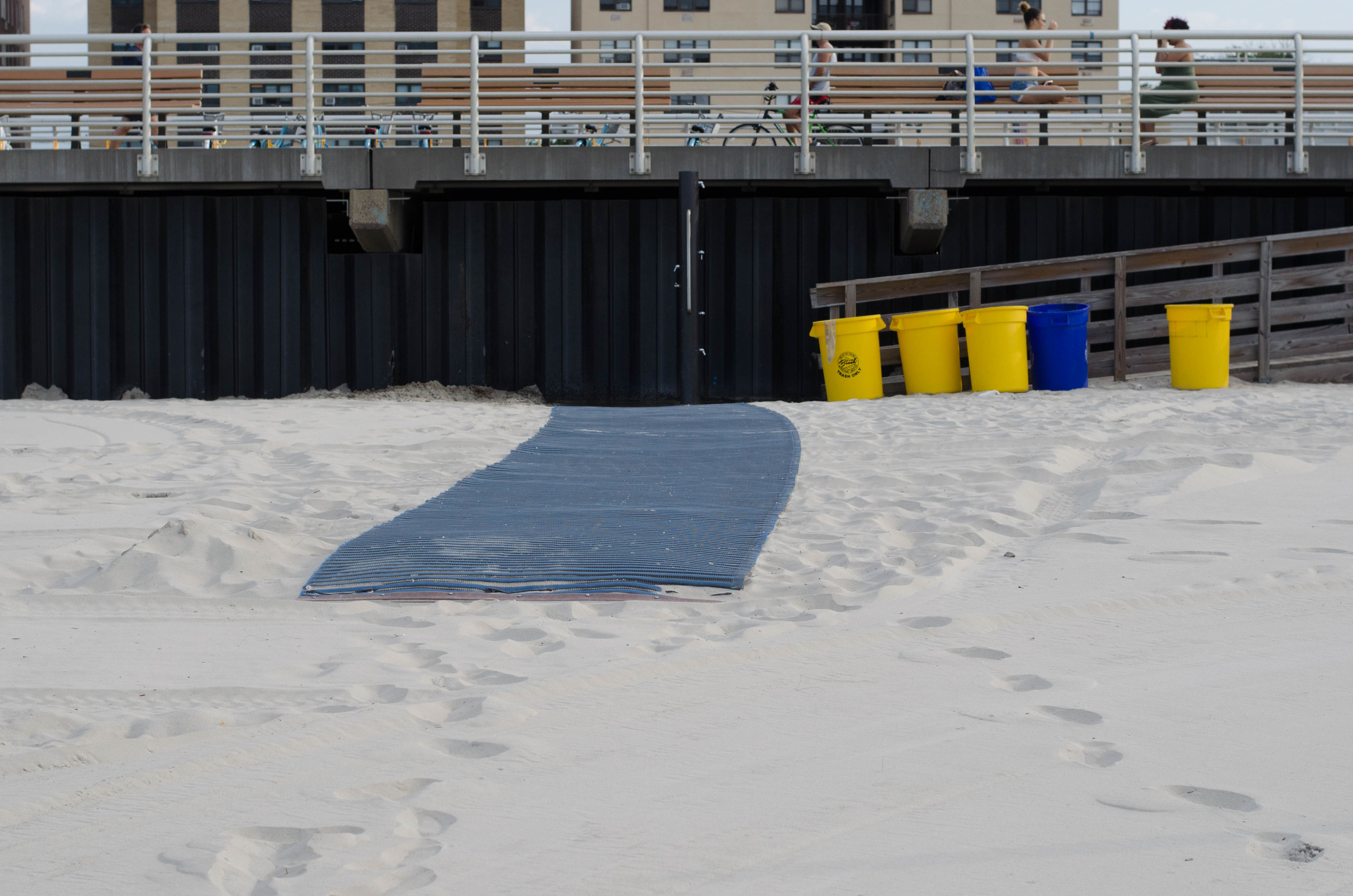Residents: beach mats fall short
City officials plan to extend path to waterline
Amid criticism from residents, city officials said last week that they plan to extend mobility mats that have been installed at four beaches this summer and make the ocean more accessible to the elderly and the disabled.
The blue, non-slip, roll-up surfaces that are intended to help beachgoers navigate the sand, called Mobi-Mats, are located at Tennessee Avenue and Edwards, Neptune and Long Beach boulevards this year, according to the city.
But many residents have voiced concerns about the mats on social media, saying that they aren’t available on enough beaches and don’t extend close enough to the water.
The city first installed the mats last year, after a petition on Change.org called on City Manager Jack Schnirman and the City Council to address the accessibility issue. It garnered more than 900 supporters, and Project 11561, the community group that created the petition, specifically sought mats on four East End and two West End beaches to make it easier for the disabled and elderly to traverse the sand.
City officials maintained that the mats were planned before the outcry from residents last year, and said that the mats “will be extended to, or in the vicinity of, the surf line of the beach.” In the past, mats did not extend that far.
But residents said that their placement was inconsistent or that they were missing altogether, and this summer marked the second year that the mats have generated controversy. “The Mobi-Mats are not used correctly,” said Long Beach resident Adam Gordon, who uses a wheelchair. “Last year they moved from beach to beach, and we never knew where they were.”
The city claimed last year that some mats were removed because they were damaged.
At the June 6 council meeting, two residents — including Liz Treston, who has advocated for “beach access for all” for close to a decade — pointed out that the mats had yet to be installed, and criticized officials for what they described as a lack of public information about their locations and what they called a slow rollout.
Resident Mindy Dovberg called on the city to install mats at every beach and extend them closer to the waterline.
“The residents that I’ve spoken to are very frustrated,” Eastholme Civic Association President Sam Pinto said. “It’s almost as if we’re back where we were two years ago, when people were calling for these mats. They’re not … as available as they should be. I’ve seen people 25 to 30 feet off the boardwalk ramp where the mat ends and there’s nowhere left for them to go.”
A 50-foot mat costs $2,800 to $3,500, city officials said. The city also offers, on request, special all-terrain wheelchairs that can be used to transport disabled or elderly people closer to the shoreline.
“If they had a section of the beach that had Mobi-Mats leading to another mat like the one they used at Flex on the Beach, people with disabilities like me in a wheelchair would buy [beach] passes,” said Gordon, referring to an annual fitness event in town. “It makes no sense for me to buy a pass, because I have to call the lifeguard in advance for a beach chair — it’s ridiculous.”
After hearing residents’ complaints, State Assemblywoman Melissa Miller — who has a disabled son — and Senate Majority Leader John Flanagan announced legislation last week that would require all state beaches to provide Mobi-Mat beach access all the way down to the high tide line, unless there is a physical barrier.
The legislation, Miller said, would ensure that the state better complies with federal Americans with Disabilities Act guidelines and regulations.
“As a mother and an advocate of a child with developmental disabilities, I know firsthand how frustrating the lack of accessibility is across New York,” said Miller, an Atlantic Beach resident. “As a Long Islander, the frustration is ten-fold, because my family loves to go to the beach — it’s a part of our way of life. For the past several months I’ve been fighting to provide full access to the high tide waterline for the disabled and elderly population. It is not enough to simply provide the legal minimum access.”
The city’s ADA compliance officer, Greg Kalnitsky, maintains that the mats comply with ADA regulations. “We’re in compliance by giving people access to the beach,” he said. “From there, the beaches are naturally inaccessible.”
Last year, Treston told the Herald that the ADA’s Title II, which protects people from discrimination on the basis of disability in services, programs and activities provided at the state and local levels, requires Long Beach to use the mats, adding that Jones Beach and Rockaway use them as well. Treston declined to comment for this story.
“We wind up with this answer of ‘We’re providing the legal minimum,’” Miller said. “Why is it enough to do the minimum? That’s making a statement to a population of people.”
Kalnitsky previously said the city was not extending the mats closer to the shoreline this year due to work by the Army Corps of Engineers — mainly trucks and emergency vehicles that drive over the mats and can damage them, creating safety hazards for beachgoers, though Miller and other residents challenged those claims.
Kalnitsky said that the process of extending the mats is not as easy as some residents make it sound. “If [Miller] can allocate a funding source, we would of course extend the mats down to the water line,” he said.
But he and other city officials announced last week that the Mobi-Mats at Tennessee Avenue would be extended to the surf line this week, to be followed by other locations later this summer.
“It’s a shame that it’s taking state legislation to motivate a local municipality to increase accessibility,” Pinto said.

 63.0°,
A Few Clouds and Breezy
63.0°,
A Few Clouds and Breezy 




